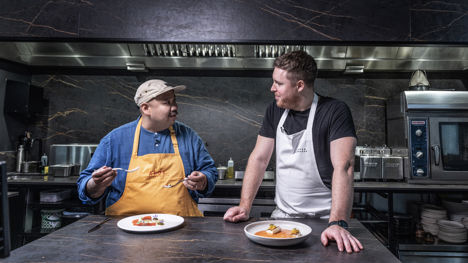
Ingredient focus: Alaska seafood
Watch chefs Steven Edwards and Budgie Montoya cook with Alaska's celebrated seafood after a recent trip to Alaska and read on below to find out more about four of its most prized catches.
Ingredient focus: Alaska seafood
Watch chefs Steven Edwards and Budgie Montoya cook with Alaska's celebrated seafood after a recent trip to Alaska and read on below to find out more about four of its most prized catches.
Few areas are as synonymous with excellent seafood as Alaska. The waters which surround the state are renowned for being a haven for marine life, brimming with everything from salmon species and whitefish like cod and pollock to huge crabs and shrimp. Its immaculate waters provide the perfect place for seafood which is packed with nutrients – including all-important omega-3 oils – to flourish, creating a world-class reputation for quality which is understood by chefs and cooks across the globe. Fishing is, after all, Alaska’s lifeblood – coastal communities in particular have been built around fishing for generations, and today it is both a culturally respected tradition and worth billions of dollars to Alaska’s economy.
Given its significance, it’s no wonder that Alaska has gone to such lengths to protect it. Sustainability is at the heart of its fishing, so important that it is even written into the constitution that it’s subject to what’s known as the ‘sustained yield’ principle. Its seafood is always wild, never farmed, and quantities and practices are overseen by strict rules and quotas put in place to make sure it remains sustainable for generations to come. All that means that seafood from Alaska feeds on a natural diet, swims freely and matures at a natural pace, factors which all shape its fantastic final texture and taste. Here, we’ve focused on just four examples of that amazing natural bounty.
Sockeye salmon
Alaska’s waters are home to five kinds of wild salmon – king, coho, keta, pink and sockeye – all with different flavours, textures and nutrient levels. Sockeye is a high-oil species prized for its rich flavour and distinctive deep red flesh, which holds onto its colour during and after cooking (it also boasts the highest protein and vitamin D content of all five). That vibrant red hue is thanks to its natural diet of krill and plankton, which contains a pigment called astaxanthin and which also means the salmon develops a distinctive flavour compared to that of farmed species. Sockeye is a firm, robust fish, the oil content of which makes it difficult to overcook, whether it’s being grilled, sautéed or smoked.
Its fattiness and rich flavour makes it perfect for sushi or sashimi, or, as chef Steven Edwards, of etch. in Hove, shows, cured. After experiencing Alaska’s produce first-hand on a trip to island Sitka, he prepared a dish of cured sockeye salmon with blackened cucumber, cucumber ketchup, horseradish and salmon roe buttermilk sauce. ‘For me, the sockeye salmon is a really unique product,’ he says. ‘It’s not just exciting to catch the salmon but to cook with it as well. I think for this particular dish it’s really nice and showcases it in a fresh form. When curing, I wanted that super freshness, and the fattiness of the salmon works well with curing.’
Black cod
Often known as sablefish, black cod is prized for its delicate, slightly sweet flavour and velvety texture. It’s actually not a member of the cod family; instead, it’s a closer relation to the Pacific grenadier. It’s found in the northern Pacific Ocean from California to Japan, but is mainly caught around the Aleutian Islands and Alaska, which is home to the world’s largest population. It also has a high oil content (about twenty times that of Atlantic cod), with the fattier collars and tips particularly desirable among chefs for their sweeter flavour and buttery texture. One of its most famous preparations is chef Nobu Matsuhisa’s miso-marinated black cod, often associated with the Japanese term gindara. Black cod is incredibly versatile, whether it’s being poached or roasted – here, Steven has created a dish of butter-roasted black cod with barbecue sweetcorn, sage and bacon.
Pollock
Known for its versatility, Alaska’s snow-white pollock fillets are flaky, with a mild taste and lean texture. Wild Alaska pollock has been recognised as among the most nutritious foods in the world, thanks to its high levels of protein, vitamin D, potassium, vitamin B12 and omega-3 fatty acids. Its versatility means it has a starring role in products used all over the world, from surimi and fish tacos to fish and chips, and also inspired chef Budgie Montoya, of London’s Filipino street food concept Apoy, to use it in his pollock escabeche. He pan-fried the pollock and served it with a sweet and sour roasted pepper sauce. ‘It’s a firm, white fish which goes well with the sweet and sour pepper notes,’ he explains. ‘I think pollock is great in terms of pan-frying, holding its shape and standing up to the sauce.’
Salmon roe
Salmon roe – or salmon caviar – are the developed, red-orange eggs of salmon. Often nicknamed golden or ruby eggs, they are high in lean protein and omega-3 fatty acids, and sometimes even considered to be packed with more nutrients than the salmon itself. A mixture of a delicate texture, briny flavour, unusual mouthfeel and vibrant aesthetic means salmon roe is popular among chefs looking to elevate their dishes, and it’s commonly spotted used in sushi and canapés in particular. Chef Budgie used the roe in his sockeye salmon sinigang – a sour soup native to the Philippines – with confit salmon and a rhubarb sinigang broth.

